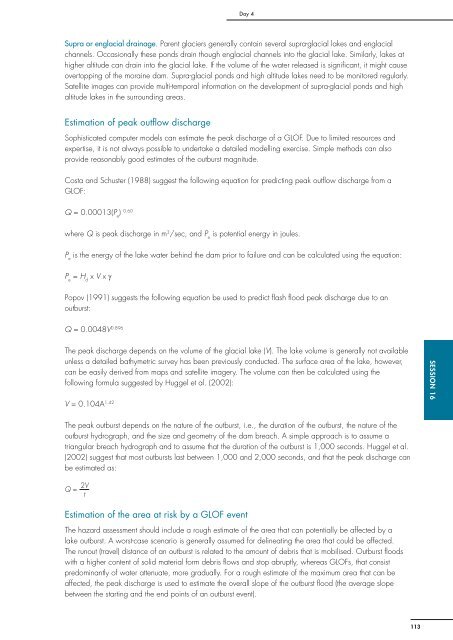Flash Flood Risk Management â A Training of Trainers ... - ReliefWeb
Flash Flood Risk Management â A Training of Trainers ... - ReliefWeb
Flash Flood Risk Management â A Training of Trainers ... - ReliefWeb
Create successful ePaper yourself
Turn your PDF publications into a flip-book with our unique Google optimized e-Paper software.
Day 4<br />
Supra or englacial drainage. Parent glaciers generally contain several supra-glacial lakes and englacial<br />
channels. Occasionally these ponds drain though englacial channels into the glacial lake. Similarly, lakes at<br />
higher altitude can drain into the glacial lake. If the volume <strong>of</strong> the water released is significant, it might cause<br />
overtopping <strong>of</strong> the moraine dam. Supra-glacial ponds and high altitude lakes need to be monitored regularly.<br />
Satellite images can provide multi-temporal information on the development <strong>of</strong> supra-glacial ponds and high<br />
altitude lakes in the surrounding areas.<br />
Estimation <strong>of</strong> peak outflow discharge<br />
Sophisticated computer models can estimate the peak discharge <strong>of</strong> a GLOF. Due to limited resources and<br />
expertise, it is not always possible to undertake a detailed modelling exercise. Simple methods can also<br />
provide reasonably good estimates <strong>of</strong> the outburst magnitude.<br />
Costa and Schuster (1988) suggest the following equation for predicting peak outflow discharge from a<br />
GLOF:<br />
Q = 0.00013(P e<br />
) 0.60<br />
where Q is peak discharge in m 3 /sec, and P e<br />
is potential energy in joules.<br />
P e<br />
is the energy <strong>of</strong> the lake water behind the dam prior to failure and can be calculated using the equation:<br />
P e<br />
= H d<br />
x V x g<br />
Popov (1991) suggests the following equation be used to predict flash flood peak discharge due to an<br />
outburst:<br />
Q = 0.0048V 0.896<br />
The peak discharge depends on the volume <strong>of</strong> the glacial lake (V). The lake volume is generally not available<br />
unless a detailed bathymetric survey has been previously conducted. The surface area <strong>of</strong> the lake, however,<br />
can be easily derived from maps and satellite imagery. The volume can then be calculated using the<br />
following formula suggested by Huggel et al. (2002):<br />
V = 0.104A 1.42<br />
session 16<br />
The peak outburst depends on the nature <strong>of</strong> the outburst, i.e., the duration <strong>of</strong> the outburst, the nature <strong>of</strong> the<br />
outburst hydrograph, and the size and geometry <strong>of</strong> the dam breach. A simple approach is to assume a<br />
triangular breach hydrograph and to assume that the duration <strong>of</strong> the outburst is 1,000 seconds. Huggel et al.<br />
(2002) suggest that most outbursts last between 1,000 and 2,000 seconds, and that the peak discharge can<br />
be estimated as:<br />
Q =<br />
2V<br />
t<br />
Estimation <strong>of</strong> the area at risk by a GLOF event<br />
The hazard assessment should include a rough estimate <strong>of</strong> the area that can potentially be affected by a<br />
lake outburst. A worst-case scenario is generally assumed for delineating the area that could be affected.<br />
The runout (travel) distance <strong>of</strong> an outburst is related to the amount <strong>of</strong> debris that is mobilised. Outburst floods<br />
with a higher content <strong>of</strong> solid material form debris flows and stop abruptly, whereas GLOFs, that consist<br />
predominantly <strong>of</strong> water attenuate, more gradually. For a rough estimate <strong>of</strong> the maximum area that can be<br />
affected, the peak discharge is used to estimate the overall slope <strong>of</strong> the outburst flood (the average slope<br />
between the starting and the end points <strong>of</strong> an outburst event).<br />
113

















